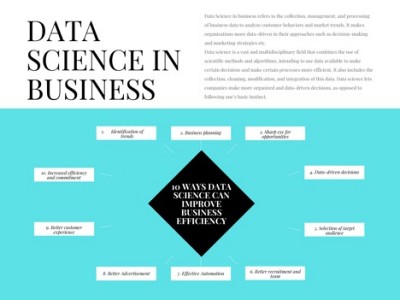Are you a newbie who has just heard about the buzzwords “data science” and “blockchain” and can’t wait to explore them? Well, once you decide to get into them, the most important question where beginners get stuck is which one of these is a better field to pick and the differences between them. Well, if that’s what you’re looking for, you’ve come to the right place!
While the terms may sound quite similar in the start since you often hear about them in similar contexts, they’re actually quite different. The focus of blockchain is to provide a decentralized technology to help with transparent record-keeping, however, data science is geared towards a thorough study of data with the end goal of adding value to business.
However, that’s a very abstract overview of both terms and we’ll dive into the specifics later on in the article, so you may have a sound grip on the fundamentals involved in both fields before deciding which one’s better for you.
So, let’s get going!
Data Science Vs Blockchain – What’s the Difference?
Data Science is a field of science that focuses on extracting useful insights from data using various techniques such as statistical analysis, data visualization, or machine learning. On the other hand, Blockchain is a ledger technology that is decentralized, distributed, and ensures transparent and secure transactions and data storage.
In simpler words, blockchain basically enables you to securely store and share your information without having to rely on a single authority such as a bank. And data science helps you understand the hidden power of numbers and other types of structured and unstructured data, enabling you to work in a data-driven manner instead of relying on your instincts alone.
Now that you have a basic overview of the differences between them, let’s dive deeper into these two powerhouses’ depths and explore their applications, strengths, and weaknesses.

Blockchain – A Complete Overview
Blockchain consists of a chain of blocks containing data about transactions linked together sequentially. It operates on a network of computers (nodes) that validate and maintain the blockchain. To ensure the validity of any data block, these computers must reach a consensus after which that block is added to the chain. Once added, it permanently becomes a part of that transparent record.
After the emergence of various cryptocurrencies such as bitcoin, this technology gained popularity and now it is being employed in multiple industries. However, its applications go far beyond digital currencies. Today, we witness the widespread adoption of blockchain in various industries, each leveraging its unique capabilities to revolutionize processes and enhance security.
The Working Behind Blockchain
The data must go through several processes before it can become a part of a blockchain.
Let’s briefly go over these processes:
- Distributed Networks: As discussed previously, there is a network of computers that work together to ensure the validity and integrity of the data by reaching a consensus.
- Blocks/Transactions: All the data about the transactions are grouped and formed into blocks that act as the building blocks for the blockchain. Here each block of data contains information about a transaction and a unique identifier called a “hash” code
- Cryptographic Hashing: To obtain the unique hash code above, a cryptographic hash function is applied to the data in each block. Changes in the data of the block will simultaneously result in changes in the hash code. Once applied, this hash code acts as the digital fingerprint for the content of the block.
- Linking: To ensure the immutability of the blockchain, all of the blocks are linked together. This link is created by attaching a reference to the previous block of data with each block. In case of any tampering with the previous block’s data, the change in the hash code will generate an alert.
- Consensus: With the help of a consensus mechanism, the agreement amongst all the network nodes validates the transaction and the order of the blocks in the blockchain. Some examples of consensus mechanisms are Proof of Work (PoW) and Proof of Stake (PoS).
- Mining: In the case of the proof of work consensus mechanism, a miner must compete to solve a complex mathematical puzzle to win the right to add a block to the blockchain. If the proof of stake mechanism is being used, the miner must put some of their cryptocurrencies as “stake” which they lose if they fail to prove their integrity.
Such processes act as an added layer of security to prevent fraudulent activities. This process also requires a lot of computational power.
- Validation and Verification: Once a new block of data has been created it’s propagated to the network where the transactions in that block are validated. To check the integrity of the data, the nodes verify the digital signatures and check if the transactions are under the rules of the blockchain.
- Consensus and Block Confirmation: Once the block has been validated and consensus is reached by the nodes it becomes a part of the blockchain. Along the way, many copies of that block are made by all the nodes to maintain backups in case of system failures.
- Transparency and Security: Blockchain is known to be transparent because the data stored within the chain is visible to all its participants. In addition to that, the decentralized nature of the blockchain and the incorporation of consensus mechanisms make sure that the data is highly secured.
Blockchain – Benefits
Let’s look at the reasons why blockchain has become such a compelling technology in various industries:
- Decentralized, Secure, and Transparent: Without a central authority, the data in a blockchain is transparent and verifiable. This level of transparency enables trust and accountability since each transaction can be traced back to its origin. Advanced security techniques such as cryptographic hashing all real-time verification make the blockchain resilient against attacks.
- Supply Chain Management and Traceability: The act of recording every transaction or event in the supply chain enables end-to-end traceability. Each participant can track the origin, movement, and authenticity of the transaction. This increases accountability and transparency and ensures quality control.
- Cross-border Transactions: Another advantage of having no intermediaries is that it allows the blockchain to streamline cross-border transactions without taking too much time or money. Not only that but it also eliminates the currency exchange and regulatory complexities.
- Smart Contracts: Smart contracts are self-executing contracts that have been provided with a predefined set of rules and conditions. Such contacts automate and enforce agreements without the need for any intermediary.
Blockchain – Limitations
While blockchain is certainly quite powerful, it comes with its own set of limitations as well. Let’s see some of the top challenges that need be to be addressed:
- Scalability: As the number of participants and transactions increases, the process of validating each transaction and reaching a consensus over a distributed network of computers slows down the transaction process.
- Energy Consumption: The use of the proof of work consensus mechanism requires a lot of computational power. Since complex computational calculations consume a lot of energy, the process of mining and securing a blockchain leads to environmental concerns.
- Storage and Bandwidth Issues: Since the entire history of the blockchain is stored over multiple computers, the storage of a multitude of transactions not only takes up a lot of space but the bandwidth need of all the nodes involved also increases.
- Lack of Legal Frameworks: Since there is no central authority that oversees the blockchain process, it becomes difficult to determine responsibility and enforce actions when disputes arise. This lack of a clear legal framework can create uncertainties and hinder widespread adoption in certain industries.
Blockchain – Applications
The applications of blockchain extend to various domains and its versatility makes it an exciting technology for innovation in many industries.
Let’s look over some notable examples of the use of blockchain:
- Healthcare: Blockchain enables the secure sharing and storage of patient information while also keeping privacy. In addition to that it eases the tracking of pharmaceuticals, clinical trials, and medical supply chains.
- Voting Systems: To enhance the integrity, transparency, and security of elections, blockchain technology has been embedded into the voting systems. This increases the trust in the voting system by making the record of votes tamper-resistant.
- Supply Chain Management: With the help of blockchain technology you can track the movement of goods, ensure their compliance with the regulations, and track authenticity. This is usually used in the food or pharmaceutical industries.
- Energy Management: Blockchain facilitates peer-to-peer energy trading, enabling individuals to buy and sell energy to each other without having to depend on central energy suppliers. This also allows you to keep track of renewable energy production and carbon credits.
-

How Data Science Can Improve Business Efficiency – 10 Ways!
-

7 Differences Between Machine Learning and Al
-

13 Reasons Why Data Is Important in Decision Making
Data Science – A Complete Overview
Data science is an innovative discipline that has become the driving force behind many breakthroughs in the world of business. Not only that but it withholds the power to transform multiple other industries as well.
Data science has become the backbone of data-driven decision-making by enabling industries to extract useful information from the data they collect and make predictions based on it. Data scientists explore and find hidden patterns in large volumes of structured and unstructured data by combining various data science techniques.
The Working Behind Data Science
Data science has enabled business owners to gain a competitive advantage. The advancements in machine learning algorithms and artificial intelligence along with the availability of big data have sped up the growth process and increased the popularity of data science today.
Let’s take a look at what steps data science processes usually consist of:
- Problem Definition: Understanding the problem’s requirements is the most crucial step, that’s why data scientists work closely with the domain experts – to understand the needs of the problem and come up with the research question that will be addressed. This allows them to set their goals and distribute resources.
- Data Acquisition: The second step is to collect data from various sources. These sources may include databases, API sensors, surveys, and social media platforms. Data engineers make sure that the data is collected properly and is accessible for analysis.
- Data Cleaning: Data in its raw form often holds missing values, inconsistencies, and noise. Before it is used for analysis, data scientists clean the data to remove redundancies and other irrelevant information.
- Exploratory Data Analysis (EDA): With the help of different statistical techniques and analyses, data scientists identify the patterns and trends hidden in the data, known as the EDA. It allows data scientists to understand the characteristics of unique features in the data and understand the relationship between them.
- Feature Engineering: The variables that capture the relevant information from the data are selected and transformed into meaningful features which are then used in the modeling to perform predictions on the unseen data.
- Model Selection: According to the data they’re working with, data scientists select a suitable model such as linear regression. Once the model is selected, they divide the data into multiple groups of training and testing sets, and then the model is trained on the data, and the outputs are evaluated to check if they meet the requirements.
- Model Training and Evaluation: Metrics such as accuracy and recall are used to evaluate the performance of the model. In case the performance is below-part, various fine-tuning techniques can be used to enhance the parameters of the model to improve the metrics.
- Interpretation of Results: The final outputs from the models are transformed into visualizations and reports so that the findings can be conveyed to the stakeholders, and they can interpret them and make data-driven recommendations.
Data Science – Benefits
Over time data science has offered us many advantages which have made it such a valuable discipline today.
Here are some key advantages that data science provides us with:
- Improved Efficiency by Making Data-driven Decisions: Analyzing the available data and identifying patterns & useful insights from it allows companies to make informed and evidence-based decisions instead of merely relying on their intuitions or experience.
- Better Customer Understanding: Analyzing customer data helps businesses understand their customer base better in terms of their preferences, needs, and buying behaviors. Eventually, this enables customizing the products, services, and marketing strategies accordingly.
- Risk Management: When data is analyzed, the anomalies in the patterns help identify fraudulent activities or any potential risks or security threats. When detected at an early stage it allows you to protect your customer’s information.
- Data-backed Innovation: Data science has fueled innovation by uncovering new opportunities because by analyzing data one can find the emerging trends or the untapped markets. It has enabled companies to move forward by making data-driven decisions.
Data Science – Limitations
Let’s take a closer look at the limitations of data science:
- Privacy Issues: Time and again, a data scientist has to work with different customers’ personal information which makes it crucial to maintain privacy and protect such information from being misused. They need to ensure that every individual’s privacy rights are secure through data anonymization, informed consent, and secure transmission and storage of data.
- Data Bias: There could be different kinds of biases present in the collected data including sampling biases, measurement biases, and algorithmic biases. The presence of such biases with the absence of fair preprocessing may lead to results that reinforce these existing inequalities.
- Overly Complex Models: When complex machine learning models are implemented such as neural networks, explaining the results from them to the stakeholders or anyone who does not have the expertise becomes difficult and this whole process becomes less transparent.
- Resource Requirements: In case you’re working with a very large dataset, this whole process becomes expensive and time-consuming because you will need a lot of resources to compute it such as high-performance hardware and adequate infrastructure, or a very skilled task force.
Data Science – Applications
As more industries recognize the value of data science, its impact will grow. Since we have gone over the advantages and limitations of data science let’s move on to some of its numerous applications:
- Government and Public Policy: At a governmental level data science helps with urban planning, crime prediction, and matters of resource allocation. This is because it allows the government to analyze large datasets and make evidence-based decisions to enhance the public services being provided.
- Social Media and Digital Marketing: For businesses that market their campaigns on social media platforms data science is a very useful technology because it allows them to monitor the social media analytics, interact with their advertisements, and perform sentiment analysis. They can keep track of what products their customers like the most and make strategies accordingly.
- Finance and Banking: In the finance and banking sector data science techniques are especially important when it comes to fraud detection, credit risk assessment, and identifying anomalies within the data. Such measures allow banks to protect their customer’s sensitive information.
- E-Commerce and Retail: Through customer sentiment analysis, business owners can keep track of their customer’s demands and provide every individual with personalized product recommendations to improve the customer experience. As a result, it has become the driving factor of increased sales.
- Sports Analytics: By collecting data such as player statistics, game footage, and other tracking data, data science can help make predictions about performance analysis, player scouting, injuries, and other game strategies.
Combining Data Science & Blockchain – Synergies, Intersections, and Factors to Consider
Although the main purpose of both technologies is different, combining the strengths of both technologies lets you create synergy and explore new and important applications.
Once combined, blockchain and data science have the power to revolutionize many industries altogether by providing them with secure, transparent, and data-driven solutions. There are factors to consider to ensure the successful integration of the two which also provides optimal outcomes.
Here is a list of some factors after in-depth exploration:
- Data Integrity and Enhanced Security: Since blockchain provides a secure platform to store data that has been verified and validated, its data can act as the ideal dataset to train data science models because it is trustworthy and tamper-proof. After the implementation of data science techniques, useful insights can be obtained about the data stored on the blockchain.
- Automated Data Analysis with Smart Contracts: Smart contracts are already automated but by incorporating data science algorithms you can enable automated data analysis, and smart decision-making that is based on predefined rules. This will also facilitate real-time insights.
- Data Marketplace: Since the incorporation of data science techniques will enable real-time insights, data buyers can make informed decisions based on the generated insights.
- Scalability and Performance: Data science can provide solutions to the problems faced during blockchain processing such as storage issues and transaction throughput with the introduction of efficient algorithms for off-chain processing or layer two solutions to handle a large number of transactions.
- Governance and Regulatory Concerns: The combination of these two technologies may raise governance and regulatory concerns. So, to navigate through the legal framework, you need to ensure privacy regulations, and consent mechanisms and make sure that the conditions are all in compliance with the applicable laws.
Wrap Up
Blockchain has overthrown the traditional systems and provided us with an incorruptible framework that has enabled us to make secure transactions and make record-keeping transparent. On the other hand, data science has empowered multiple businesses to predict customer buying behavior, make informed decisions, and perfect their operations.
Although both technologies thrive in different domains, there are some instances where they complement each other’s strengths making it crucial to understand the potential for constructive collaboration between these two.
Declaring a definitive winner is rather complicated considering both technologies have proved to be valuable in their respective domains. Ultimately, the choice depends on the context of the situation at hand and its requirements.
If you’ve given the article a thorough read, I’m sure you would’ve been able to pick the right one for you by now, depending upon your goals and skillsets. If not, here’s a summary table for you containing all the details you need to find the answer for you:
| Blockchain | Data Science | |
| Data Handling | Data stored in a tamper-evident manner where each participant has a copy of the entire blockchain | Heaps of structured and unstructured data analyzed and processed using statistical and machine learning techniques |
| Data Source | Transaction data, smart contract data or specific data entries | Works with all sorts of diverse data sources |
| Techniques | Cryptographic techniques, consensus algorithms and decentralized governance models | Statistical analysis, machine learning algorithms, data visualizations and predictive modelling |
| Applications | Cryptocurrency, supply chain management and decentralized finance (DeFi) | Business analytics, healthcare, finance, recommender systems |
| Data Governance and Collaboration | Decentralized governance and collaborations are between network participants | Privacy regulations and organization policies and collaborations are between data scientists and domain experts |

